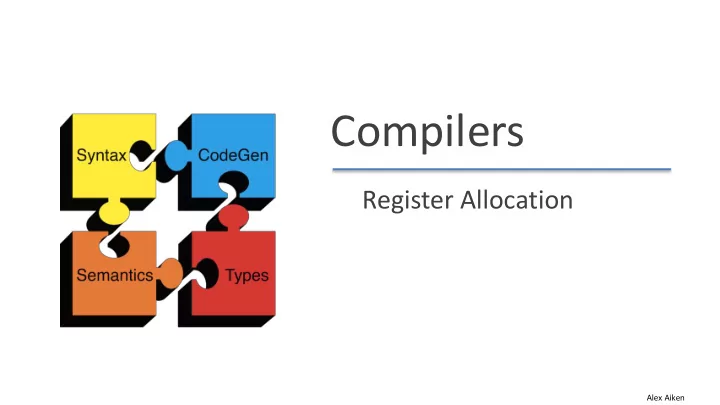

Compilers Register Allocation Alex Aiken
Register Allocation • Intermediate code uses unlimited temporaries – Simplifies code generation and optimization – Complicates final translation to assembly • Typical intermediate code uses too many temporaries Alex Aiken
Register Allocation • The problem: Rewrite the intermediate code to use no more temporaries than there are machine registers • Method: – Assign multiple temporaries to each register – But without changing the program behavior Alex Aiken
Register Allocation • • Can allocate a, e, and f all to Consider the program one register (r 1 ): a := c + d e := a + b r 1 := r 2 + r 3 f := e - 1 r 1 := r 1 + r 4 r 1 := r 1 - 1 • Assume a & e dead after use – A dead temporary can be “reused” Alex Aiken
Register Allocation • Register allocation is as old as compilers – Register allocation was used in the original FORTRAN compiler in the ‘50s – Very crude algorithms • A breakthrough came in 1980 – Register allocation scheme based on graph coloring – Relatively simple, global and works well in practice Alex Aiken
Register Allocation Temporaries t 1 and t 2 can share the same register if at any point in the program at most one of t 1 or t 2 is live. Or If t 1 and t 2 are live at the same time, they cannot share a register Alex Aiken
Register Allocation • Compute live variables for each point: {b,c,f} a := b + c {a,c,f} d := -a {c,d,f} e := d + f {c,d,e,f} {c,e} b := d + e f := 2 * e {b,c,e,f} e := e - 1 {c,f} {c,f} {b,c,f} {b} b := f + c {b} Alex Aiken
Register Allocation • Construct an undirected graph – A node for each temporary – An edge between t 1 and t 2 if they are live simultaneously at some point in the program • This is the register interference graph (RIG) – Two temporaries can be allocated to the same register if there is no edge connecting them Alex Aiken
Register Allocation a • For our example: b f c e d • E.g., b and c cannot be in the same register • E.g., b and d could be in the same register Alex Aiken
Register Allocation Which of the following pairs of temporaries interfere in the code fragment given at right? A := 1 1 B := A * 2 2 A and B C := C - B 3 A and C A := B + 1 4 A < 16 5 B and C D := C + 1 6 C and D
Register Allocation • Extracts exactly the information needed to characterize legal register assignments • Gives a global (i.e., over the entire flow graph) picture of the register requirements • After RIG construction the register allocation algorithm is architecture independent Alex Aiken
Recommend
More recommend